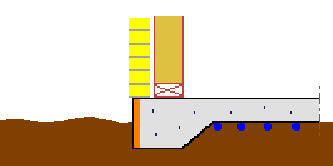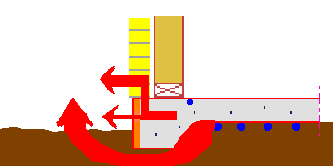EDGE INSULATION
A buildings weakest area!
A building is often done with concrete on the ground. In such cases it has been shown that a substantial heat lose is done through the edge.
This also includes buildings with floor heating.

edge of the plate on the ground
The figure shows a concrete plate (flat on the ground, gray). On the outer façade of brick and then invokes a mineral insulated wall.
Karlsson Klimat recommends giving the floor loops (blue) in the bottom or below the concrete while others are floor heating manufacturers prefer to add loops in the concrete top.
Let us first look at the conditions if you do not have floor heating.
Experience shows it is known that there will be very cold in the angle between the plate and wall, eg to room air can easily be standing there,
especially in such as a bed placed against the outer wall. It has therefore been the practice (and still is) to put a hot wire in a groove in the floor next to the outer wall surface.
If you have electric heating, a heating cable, when water heating, a heating tube.
Where does the heat from the heating tube go?
First run through the concrete horizontally to the open air and the heat goes down to the ground but through that it is so close to the edge is
the heat in a half circle and out into the open.
One can show that the specific heat loss horizontally is 15 W/K for a house with measurements of 15 x 8 m, which compares with the maximum transmission 70 W/K.
If the edge of the beam is isolated (usually isolated only 5 cm foam electricity etcetera.) are loss of approximately 4 W/K.

"Edge" at the plate on the ground
Heat flow downwards and in a semicircle to the outdoor air can be demonstrated on 1 m wide 'strip' in from the outer facing 50 W/K if no insulation is.
With insulation 5 cm specific loss drops to 21 W/K and with 10 cm insulation to 14 W/K. Even if the insulation is increased to 20 cm is still loss of 8 W/K.
Heat losses from the edge of the beam is very large. Even with a very good insulation, the losses will be more than 10% of the total transmission losses.
Consider now the cases that arise if you have floor heating. Losses are increasing as is the floor plate is heated to between 5 and 10 degrees higher temperature
than other heating systems. This means that the specific losses increase by about 50%, which in turn means that even with good insulation around the edge of the beam
is the transmission through the edge about 15% of the total transmission.
Conclusion: It is not enough to isolate the edge of a plate on the ground. This applies to both heating and for other heating systems.
The insulation must be at least 10 cm thick, preferably 20 cm, and it must extend at least 1 m downward or horizontally out from the facade.
The part of the plate which is over land must LIKEWISE be isolated.
Unlike the edge of the insulation is less important as insulation during the remainder of the plate where the groundwater is several meters (more than 3 m) below the plate.
In such cases, the soil is an isolation and build up a heat pad under the house.



 edge of the plate on the ground
edge of the plate on the ground  "Edge" at the plate on the ground
"Edge" at the plate on the ground